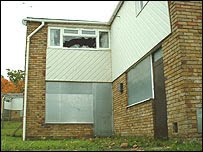
This week the US federal government admitted to holding on to 50,000 vacant homes. It was rightly reported as a scandal; but what about the UK? How many empty homes is our government sitting on? By my estimate the problem is proportionately worse here, but the real scandal is we don’t actually know. Data on privately owned empty homes is widely available, But official data on the government’s empty housing stock must count as one of the worst compiled and most obscure sets of statistics available. The official figure says they own 4,802 empty homes. See column “AQ” here if you want the source. What’s wrong with it?
Firstly it’s untrue. Just one government agency (Defence Estates) admits to owning double that number, and there are tens of other property-holding agencies and government departments. And that’s before we have even considered one of the biggest sinners – the NHS.
Secondly it’s complied by people who don’t know. This figure is a sum of what each local authority in England thinks there might be in its area. But they have no real way of knowing. Government who should know the answer, just collates an estimate from other people who don’t know.
Thirdly would you have found the figure buried in an obscure spreadsheet called HSSA with a column entitled “other public”? No. It’s hidden where nobody will find it, and not mentioned anywhere else (until now!).
Government Agencies like the NHS and MOD seem to have a particular problem with empty homes. The MOD has a vacancy rate of 17%, ten times the rate of an average housing association. Of course there are special reasons, but the main one is they are an organisation that does something else- defence. They are not good property managers. And of course they are publicly funded, so management failure just gets absorbed as a cost, with no adverse consequences. The MOD are not alone, it’s what happens with most big organisations that have a bit of residential accommodation on the side. Many government agencies have a historic stock of staff living accommodation that is no longer made available to staff, others like the Department of Transport historically owned hundreds of vacant homes that they held as a land bank for future road expansion.
The first step to tackling any problem is owning up to it in the first place. The government has rightly issued guidance about how others should bring empty properties back into to use, but remains highly secretive about the empty homes it owns itself. Yes there are more privately than publicly owned empty homes, but that doesn’t excuse inaction on the publicly owned ones. The first step is for government to audit it’s own housing stock and publish the list of empty homes they own. It might, like in the States, cause people to say it’s a scandal. But it will be less of a scandal than what we have now- secrecy.
 Vice Admiral Timothy Lawrence, Chief Executive of Defence Estates recently said he thought he’d made a rod for his own back over his target to reduce vacancy levels in MOD homes from their current incredibly high 17% rate.
Vice Admiral Timothy Lawrence, Chief Executive of Defence Estates recently said he thought he’d made a rod for his own back over his target to reduce vacancy levels in MOD homes from their current incredibly high 17% rate.



